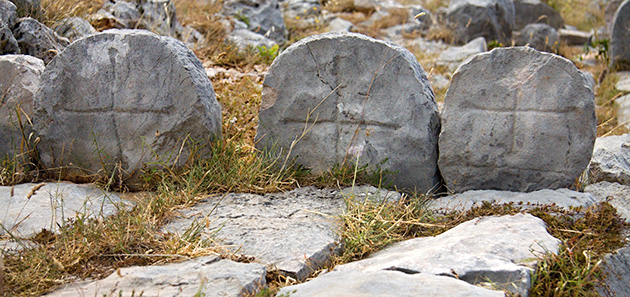
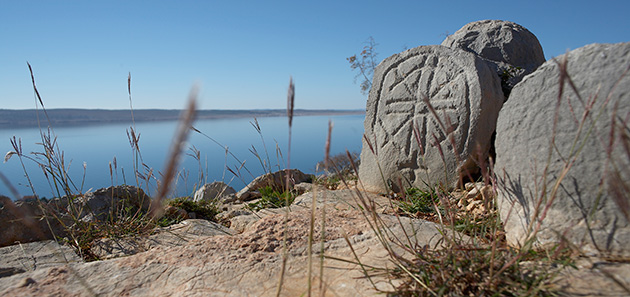
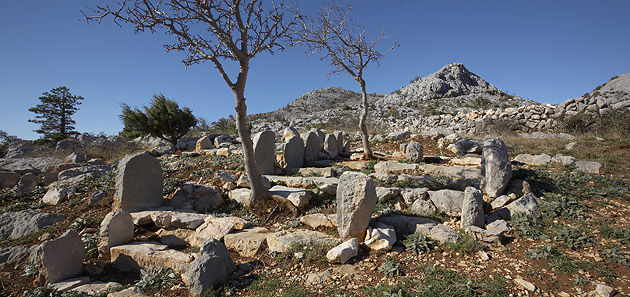
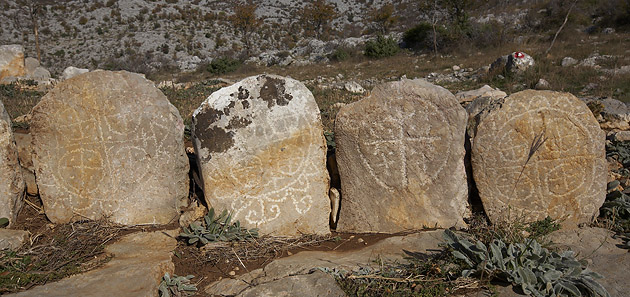
Attractions › Mirila
Mirila represent a distinctive phenomenon endemically found on karst slopes of southern Velebit mountain. They are in fact memorials of life of the local people captured in stone, a stone in stone, an eternal seal. *
Any stone can form a mirilo. Once part of mirilo, it will never again be a common stone. **
Mirila – stone monuments of a unique funeral custom are found along mountain paths on Velebit passes, elevations and glades. They were made during a period of extensive life in the mountain hamlets, when people live and survived mostly of livestock farming (17th – 20th century).
People who lived at the foothill of Velebit mountain had always raised livestock because the mountaintops and karst slopes provided abundant green pastures. With the coming of spring, people would take their herds up on the higher slopes in search of better grazing areas, and in autumn they would return to their moderate coastal homes. *
When their loved ones passed away in the mountain hamlets, they would carry them to the graveyard which was always located at the foothill of the mountain. The funeral procession would make a stop during the arduous march and lay the deceased on the ground only once, at the special place – a place of the deceased’s final farewell to the Sun. The spot where they would lay the deceased would be marked by stones and built into a mirilo – ‘mjera’ (mira) meaning measure. They would take a measure of the body of the deceased with flat slab-like stones, mar it by a headstone and footstone and carve an artistic work into a shallow relief on the headstone. Acording to some oral traditions, mirila also signified peace for the soul of the deceased.
Mystical artwork carved into the headstones contains different elements of artistic expression of ancient cultures and early Christianity to iconography belonging to the Bosnian Stećci medieval tombstones. Inscriptions are rare and belong to more recent times.
The change in lifestyle made this funeral cult slowly disappear. However, the stone markings bear witness of an entire age of life on Velebit mountain. Scientist continue to research mirila, namely their origin, age and significance as numerous questions still remain unanswered. In the meanwhile, traditions related to mirila have been protected as intangible cultural heritage of the Republic of Croatia.
There are two educational paths that take you on a visit to mirila. It is possible to tour other mirila sites preserved along Paklenica Riviera. Find out more about mirila at Ethno House Marasović or visit the virtual exhibition Mirila at www.mirila.org
* dr. sc. Tomo Vinščak (1951. – 2013.)
** Josip Zanki, artist
EDUCATIONAL PATH STARIGRAD
- Time necessary for the tour: 3 h
- Difficulty of path: easy
- Length of path: 2,6 km
- Necessary equipment: sports clothing and shoes, water
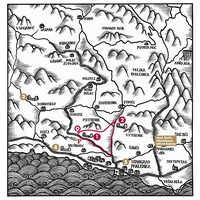
Despite their rustic simplicity, the artistic expression on mirila headstones of Starigrad fascinate by sheer richness of headstones relief ornaments. A short walk from the center of Starigrad through the streets Ulica Put Bunara – Velebitska ulica – Ulica A. Stepinca will lead you to the first mirila site on this path. After 900 m the path reaches a plateau overlooking the sea where the site Nad Kruškovcem (1) is located – just opposite of the plateau in immediate vicinity to the road. This site is also notable for a very rare headstone with anthropomorphic (man-like) symbol.
The path connects to a hiking trail towards the site Opuvani dolac (2) which contains mirila of the most distinctive traits, specifically the iconography of the headstones which range from the simplest depictions of crosses – latin, Greek, solar and anthropomorphic , combined with solar circles, to undetermined rosetta symbols, spirals or četverokuka motifs, their meanings lost over time with their creators…A well paved stone path down the steep slope of Veliki Vitrenik will take you on a return path to Starigrad.
It is also possible to start the educational path from the opposite direction if you proceed straight instead of turning left from the top of Ulica A. Stepinca and ascend towards the site Opuvani dolac.
For more on fascinating culture, customs and traditions of coastal area at the foot of Velebit mountain we recommend a walk towards Marasović Ethno House.
EDUCATIONAL PATH LJUBOTIĆ
- Time necessary for the tour: 5 h
- Difficulty of path: medium
- Length of path: 7,7 km
- Necessary equipment: sports clothing and shoes, water
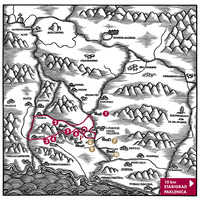
The trail starts and ends next to the church in Ljubotić hamlet, one of rare still inhabited villages of southern Velebit mountain. Starting at the road heading north, the trail turns left along the fence wall of Vrata Velebita household. The climb towards Renjevačka mirila (1) starts between the last houses of Ljubotić and offers a beautiful panoramic view of the sea.
The path then branches left and goes downwards to the valley bordered by a decent looking dirt road. It leads to Bristovačka mirila (2) – the largest preserved site with over 300 mirila. The trail continues towards Livodice hamlet where it turns left and from there on easily downwards to the sea. At a grass covered plateau the trail again turns left and through a deserted hamlet of Križ continues over an interesting karst plateau to a spacious terrace wit two curiously positioned sites (3-4) and a belvedere at the edge of a cliff. A light hike top the hamlet of Lug Paripov will take you on the road back to Ljubotić hamlet. A careful observer might notice two smaller sites hidden from clear view (5, 6), just before the church.
There are several other, easily accessible interesting sites in near vicinity, just off the road to Ljubotić hamlet (7-10).
An announced visit to Vrata Velebita household and their ethno house with permanent display of bee-keeping, Velebit honey tastings and other home-made delicacies will complete the overall experience.








